User:Dinonick1/sandbox
| Jaguar Temporal range: Middle Pleistocene – Recent
| |
|---|---|
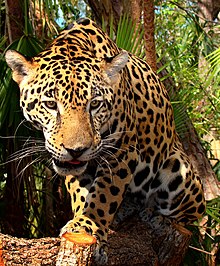
| |
| Scientific classification | |
| Domain: | Eukaryota |
| Kingdom: | Animalia |
| Phylum: | Chordata |
| Class: | Mammalia |
| Order: | Carnivora |
| Suborder: | Feliformia |
| Family: | Felidae |
| Subfamily: | Pantherinae |
| Genus: | Panthera |
| Species: | P. onca
|
| Binomial name | |
| Panthera onca | |
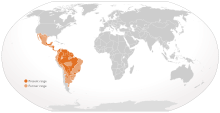
| |
| Jaguar range | |
The jaguar (Panthera onca) is a
This spotted cat most closely resembles the
The jaguar is a
Etymology
The word 'jaguar' comes to English from one of the Tupi–Guarani languages, presumably the Amazonian trade language Tupinambá, via Portuguese jaguar.[5] The Tupian word, yaguara "beast", is sometimes translated as "dog".[6][7] The specific word for jaguar is yaguareté, with the suffix -eté meaning "real" or "true".[5][8]
The first component of its taxonomic designation, Panthera, is Latin, from the Greek word for leopard, πάνθηρ, the type species for the genus. This has been said to derive from the παν- "all" and θήρ from θηρευτής "predator", meaning "predator of all" (animals), though this may be a folk etymology[9]—it may instead be ultimately of Sanskrit origin, from pundarikam, the Sanskrit word for "tiger".[10] In Mexican Spanish, its nickname is el tigre: 16th century Spaniards had no native word in their language for a cat smaller than a lion but bigger than a leopard nor had ever encountered such a creature in the Old World, and so named it after a cat whose ferocity would have only been known to them through Roman writings, popular literature during the Renaissance.[11]
Onca is the Portuguese
Taxonomy and evolution
The jaguar, Panthera onca, is the only extant New World member of the genus Panthera.
Based on morphological evidence, British
While jaguars now live only in the Americas, they are descended from Old World cats. Two million years ago, scientists believe, the jaguar and its closest relative, the similarly spotted leopard, shared a common ancestor in Asia.[19] In the early Pleistocene, the forerunners of modern jaguars crossed Beringia, the land bridge that once spanned the Bering Strait and connected Asia and North America. These jaguar ancestors then moved south into Central and South America, feeding on the deer and other grazing animals that once covered the landscape in huge herds.[19]
Geographical variation
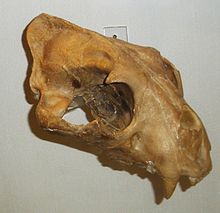
The last taxonomic delineation of the jaguar subspecies was performed by Pocock in 1939. Based on geographic origins and skull morphology, he recognized eight subspecies. However, he did not have access to sufficient specimens to critically evaluate all subspecies, and he expressed doubt about the status of several. Later consideration of his work suggested only three subspecies should be recognized.[20]
Recent studies have also failed to find evidence for well-defined subspecies, which are no longer recognized.
Pocock's subspecies divisions are still regularly listed in general descriptions of the cat.[24] Seymour grouped these in three subspecies.[20]
- Panthera onca onca: Venezuela through the Amazon, including
- P. o. peruviana (Peruvian jaguar): Coastal Peru
- P. o. peruviana (
- P. o. hernandesii (Mexican jaguar'): Western Mexico – including
- P. o. centralis (Central American jaguar): El Salvador to Colombia
- P. o. arizonensis (Arizonan jaguar): Southern Arizona to Sonora, Mexico
- P. o. veraecrucis (Panthera onca veraecrucis): Central Texas to southeastern Mexico
- P. o. goldmani (Goldman's jaguar): Yucatán Peninsula to Belize and Guatemala
- P. o. centralis (
- P. o. palustris (Pantanal jaguar, it is the largest subspecies, weighing more than 135 kg or 300 lb):[25] The Pantanal regions of Mato Grosso and Mato Grosso do Sul, Brazil, along the Paraguay River into Paraguay and northeastern Argentina.
The Mammal Species of the World continues to recognize nine subspecies, the eight subspecies above and additionally P. o. paraguensis.[26] In addition, extinct subspecies P. o. augusta and P. o. mesembrina lived throughout the Americas during the Pleistocene.
Biology and behavior
Physical characteristics

The jaguar, a compact and well-muscled animal, is the largest cat in the New World and the largest carnivorous mammal in Central and South America.[27] Size and weight vary considerably: weights are normally in the range of 56–96 kg (124–211 lb). Larger males have been recorded to weigh as much as 158 kg (348 lb)[21][28] (roughly matching a tigress or lioness; however note this animal was weighed with a full stomach).[29] The smallest females have low weights of 36 kg (79 lb).[21] Females are typically 10–20 percent smaller than males. The length, from the nose to the base of the tail, of the cats varies from 1.12 to 1.85 m (3.7 to 6.1 ft). Their tails are the shortest of any big cat, at 45 to 75 cm (18 to 30 in) in length.[21][30] Their legs are also short, considerably shorter when compared to a small tiger or lion in a similar weight range, but are thick and powerful. The jaguar stands 63 to 76 cm (25 to 30 in) tall at the shoulders.[31] Compared to the similarly colored Old World leopard, the jaguar is bigger, heavier and relatively stocky in build.[20]
Further variations in size have been observed across regions and habitats, with size tending to increase from the north to south. A study of the jaguar in the Chamela-Cuixmala Biosphere Reserve on the Mexican Pacific coast, showed ranges of just about 50 kg (110 lb), about the size of a female cougar.[32] Jaguars in Venezuela or Brazil are much larger with average weights of about 95 kg (220 lb) in males and of about 56 kilograms (123 lb) to 78 kilograms (172 lb) in females.[20] In the Brazilian Pantanal, weights of 136 kilograms (300 lb) or more are not uncommon in old males,[33] with the highest recorded weight, for a Jaguar weighed on an empty stomach being 148 kilograms (326 lb).[34] Forest jaguars are frequently darker and considerably smaller than those found in open areas (the Pantanal is an open wetland basin), possibly due to the smaller numbers of large, herbivorous prey in forest areas.[35]
A short and stocky limb structure makes the jaguar adept at climbing, crawling, and swimming.[31] The head is robust and the jaw extremely powerful, it has the third highest bite force of all felids, after the lion and tiger. A 100 kg (220 lb) jaguar can bite with a force of 503.57 kgf (1110 lbf) at canine teeth and 705.79 kgf (1556 lbf) at carnassial notch.[36] This strength adaptation allows the jaguar to pierce turtle shells.[3] A comparative study of bite force adjusted for body size ranked it as the top felid, alongside the clouded leopard and ahead of the lion and tiger.[37] It has been reported that "an individual jaguar can drag an 800 lb (360 kg) bull 25 ft (7.6 m) in its jaws and pulverize the heaviest bones".[38] The jaguar hunts wild animals weighing up to 300 kg (660 lb) in dense jungle, and its short and sturdy physique is thus an adaptation to its prey and environment.
Coloration
The base coat of the jaguar is generally a tawny yellow, but can range to reddish-brown and black, for most of the body. However, the
While the jaguar closely resembles the leopard, it is sturdier and heavier, and the two animals can be distinguished by their rosettes: the rosettes on a jaguar's coat are larger, fewer in number, usually darker, and have thicker lines and small spots in the middle that the leopard lacks. Jaguars also have rounder heads and shorter, stockier limbs compared to leopards.[39]
Color morphism
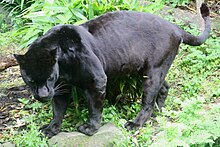
Color morphism occurs in the species. A near-black melanistic form occurs regularly. Jaguars with melanism appear entirely black, although their spots are still visible on close examination.
The black morph is less common than the spotted form but, at about six percent of the population,[40] it is several orders of magnitude above the mutation rate. Hence, it is being supported by selection. Some evidence indicates the melanism allele is dominant.[41] The black form may be an example of heterozygote advantage; breeding in captivity is not yet conclusive on this.
Melanistic jaguars are informally known as black panthers, but (as with all forms of polymorphism) they do not form a separate species.
Extremely rare
Reproduction and life cycle

Jaguar females reach
Pairs separate after mating, and females provide all parenting. The gestation period lasts 93–105 days; females give birth to up to four cubs, and most commonly to two. The mother will not tolerate the presence of males after the birth of cubs, given a risk of infanticide; this behavior is also found in the tiger.[44]
The young are born blind, gaining sight after two weeks. Cubs are weaned at three months, but remain in the birth den for six months before leaving to accompany their mother on hunts.
Social activity

Like most cats, the jaguar is solitary outside mother–cub groups. Adults generally meet only to court and mate (though limited noncourting socialization has been observed anecdotally
Like the other big cats, the jaguar is capable of roaring[49][50] and does so to warn territorial and mating competitors away; intensive bouts of counter-calling between individuals have been observed in the wild.[51] Their roar often resembles a repetitive cough, and they may also vocalize mews and grunts.[33] Mating fights between males occur, but are rare, and aggression avoidance behavior has been observed in the wild.[47] When it occurs, conflict is typically over territory: a male's range may encompass that of two or three females, and he will not tolerate intrusions by other adult males.[44]
The jaguar is often described as
Hunting and diet
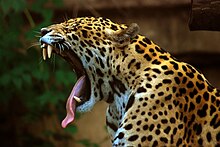
Like all cats, the jaguar is an obligate
There is evidence that jaguars in the wild consume the roots of Banisteriopsis caapi.[55]
While the jaguar often employs the deep throat-bite and suffocation technique typical among Panthera, it sometimes uses a killing method unique amongst cats: it pierces directly through the temporal bones of the skull between the ears of prey (especially the capybara) with its canine teeth, piercing the brain.[56] This may be an adaptation to "cracking open" turtle shells; following the late Pleistocene extinctions, armored reptiles such as turtles would have formed an abundant prey base for the jaguar.[35][51] The skull bite is employed with mammals in particular; with reptiles such as the caiman, the jaguar may leap onto the back of the prey and sever the cervical vertebrae, immobilizing the target. When attacking sea turtles, including the huge Leatherback sea turtle which weighs about 385 kg (849 lb) on average, as they try to nest on beaches, the jaguar will bite at the head, often beheading the prey, before dragging it off to eat.[57] Reportedly, while hunting horses, a jaguar may leap onto their back, place one paw on the muzzle and another on the nape and then twist, dislocating the neck. Local people have anecdotally reported that when hunting a pair of horses bound together, the jaguar will kill one horse and then drag it while the other horse, still living, is dragged in their wake.[58] With prey such as smaller dogs, a paw swipe to the skull may be sufficient to kill it.

The jaguar is a stalk-and-ambush rather than a chase predator. The cat will walk slowly down forest paths, listening for and stalking prey before rushing or ambushing. The jaguar attacks from cover and usually from a target's blind spot with a quick pounce; the species' ambushing abilities are considered nearly peerless in the animal kingdom by both indigenous people and field researchers, and are probably a product of its role as an apex predator in several different environments. The ambush may include leaping into water after prey, as a jaguar is quite capable of carrying a large kill while swimming; its strength is such that carcasses as large as a heifer can be hauled up a tree to avoid flood levels.[44]
On killing prey, the jaguar will drag the carcass to a thicket or other secluded spot. It begins eating at the neck and chest, rather than the midsection. The heart and lungs are consumed, followed by the shoulders.[44] The daily food requirement of a 34 kg (75 lb) animal, at the extreme low end of the species' weight range, has been estimated at 1.4 kg (3.1 lb).[59] For captive animals in the 50–60 kg (110–130 lb) range, more than 2 kg (4.4 lb) of meat daily are recommended.[60] In the wild, consumption is naturally more erratic; wild cats expend considerable energy in the capture and kill of prey, and they may consume up to 25 kg (55 lb) of meat at one feeding, followed by periods of famine.[61] Unlike all other Panthera species, jaguars very rarely attack humans. However, jaguar attacks appear to be on the rise with increased human encroachment on their habitat and a decrease in prey populations.[62] Sometimes jaguars in captivity attack zookeepers.[63]
Ecology
Distribution and habitat
The jaguar has been an American cat since crossing the

The inclusion of the United States in the list is based on occasional sightings in the southwest, particularly in
Completion of the
The historic range of the species included much of the southern half of the United States, and in the south extended much farther to cover most of the South American continent. In total, its northern range has receded 1,000 km (621 mi) southward and its southern range 2,000 km (1243 mi) northward.
The habitat of the cat includes the rain forests of South and Central America, open, seasonally flooded wetlands, and dry grassland terrain. Of these habitats, the jaguar much prefers dense forest;[35] the cat has lost range most rapidly in regions of drier habitat, such as the Argentine pampas, the arid grasslands of Mexico, and the southwestern United States.[1] The cat will range across tropical, subtropical, and dry deciduous forests (including, historically, oak forests in the United States). The jaguar prefers to live by rivers, swamps, and in dense rainforest with thick cover for stalking prey. Jaguars have been found at elevations as high as 3,800 m, but they typically avoid montane forest and are not found in the high plateau of central Mexico or in the Andes.[35] The jaguars preferred habitats are usually swamps and wooded regions, but jaguars also live in scrublands and deserts.[71]
Ecological role
The adult jaguar is an
The jaguar also has an effect on other predators. The jaguar and the
Conservation status

Jaguar populations are rapidly declining. The animal is considered
Given the inaccessibility of much of the species' range, particularly the central Amazon, estimating jaguar numbers is difficult. Researchers typically focus on particular bioregions, thus species-wide analysis is scant. In 1991, 600–1,000 (the highest total) were estimated to be living in Belize. A year earlier, 125–180 jaguars were estimated to be living in Mexico's 4,000-km2 (2400-mi2) Calakmul Biosphere Reserve, with another 350 in the state of Chiapas. The adjoining Maya Biosphere Reserve in Guatemala, with an area measuring 15,000 km2 (9,000 mi2), may have 465–550 animals.[77] Work employing GPS telemetry in 2003 and 2004 found densities of only six to seven jaguars per 100 km2 in the critical Pantanal region, compared with 10 to 11 using traditional methods; this suggests the widely used sampling methods may inflate the actual numbers of cats.[78]
The major risks to the jaguar include
The jaguar is regulated as an
Jaguars in the United States

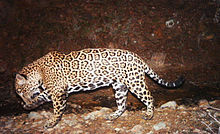
The only extant cat native to North America that roars,
Jaguars were rapidly eliminated in the United States. The last female jaguar in the United States was shot by a hunter in Arizona's White Mountains in 1963. Arizona outlawed jaguar hunting in 1969, but by then no females remained and over the next 25 years only two male jaguars were found (and killed) in Arizona. Then in 1996, Warner Glenn, a rancher and hunting guide from Douglas, Arizona, came across a jaguar in the Peloncillo Mountains and became a jaguar researcher, placing webcams which recorded four more Arizona jaguars.[84] None of the other four male jaguars sighted in Arizona in the last 15 years have been seen since 2006.[85] Then, in 2009, a male jaguar named Macho B, died shortly after being radio-collared by Arizona Game and Fish Department (AGFD) officials in 2009. In the Macho B incident, a former AGFD subcontractor pleaded guilty to violating the endangered species act for trapping the cat and a Game and Fish employee was fired for lying to federal investigators.[79] In 2011, a 200-pound male jaguar was photographed near Cochise in southern Arizona by a hunter after being treed by his dogs (the animal left the scene unharmed). A second 2011 sighting of an Arizona jaguar was reported by a Homeland Security border pilot in June 2011, and conservation researchers sighted two jaguars within 30 miles of the Mexico/U.S. border in 2010.[79] In September 2012, a jaguar was photographed in the Santa Rita Mountains of Arizona, the second such sighting in this region in two years.[86] Apparently this jaguar has been photographed numerous times over the past nine months through June 2013.[87] On February 3, 2016, the Center for Biological Diversity released a video of this jaguar - now named El Jefe - roaming the Santa Rita Mountains, about 25 miles south of downtown Tucson.[88]
Legal action by the
Conservation approaches
Current conservation efforts often focus on educating ranch owners and promoting ecotourism.[94] The jaguar is generally defined as an umbrella species – its home range and habitat requirements are sufficiently broad that, if protected, numerous other species of smaller range will also be protected.[95] Umbrella species serve as "mobile links" at the landscape scale, in the jaguar's case through predation. Conservation organizations may thus focus on providing viable, connected habitat for the jaguar, with the knowledge other species will also benefit.[94]
Jaguar conservation is complicated by the species' extremely large range which spans 18 countries with different policies and regulations. One approach has been to pinpoint specific areas of high importance for jaguar conservation efforts, so-called "hotspots". These hotspots, described as jaguar conservation units, are large areas populated by about 50 jaguars. This method has been used in tiger conservation, and has seen some success. Each unit was graded on a scale integrating unit size, connectivity, habitat quality, jaguar hunting, prey hunting, and jaguar population status into a prioritization assessment. The result of an analysis across the Jaguar’s historic range was the identification of about 51 areas that are priorities for jaguar conservation.[96] However, recent studies underlined that to maintain the robust exchange across the jaguar gene pool necessary for maintaining the species, it is important that jaguar habitats are interconnected. To facilitate this, a new project, the Paseo del Jaguar, has been established to connect several jaguar hotspots.[97]
In setting up protected reserves, efforts generally also have to be focused on the surrounding areas, as jaguars are unlikely to confine themselves to the bounds of a reservation, especially if the population is increasing in size. Human attitudes in the areas surrounding reserves and laws and regulations to prevent poaching are essential to make conservation areas effective.[98]
To estimate population sizes within specific areas and to keep track of individual jaguars, camera trapping and wildlife tracking telemetry are widely used, and feces may be sought out with the help of detector dogs to study jaguar health and diet.[99][100]
Ecotourism setups are being used to generate public interest in charismatic animals such as the jaguar, while at the same time generating revenue that can be used in conservation efforts. Audits done in Africa have shown that ecotourism has helped in African cat conservation. As with large African cats, a key concern in jaguar ecotourism is the considerable habitat space the species requires, so if ecotourism is used to aid in jaguar conservation, some considerations need to be made as to how existing ecosystems will be kept intact, or how new ecosystems that are large enough to support a growing jaguar population will be put into place.[101]
In mythology and culture
Pre-Columbian Americas

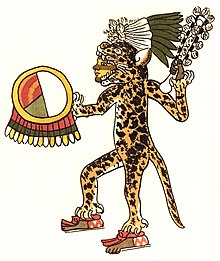
In
In
Contemporary culture
The jaguar and its name are widely used as a symbol in contemporary culture. It is the
Jaguar is widely used as a product name, most prominently for a
See also
- List of solitary animals
References
- ^ a b c d e "Panthera onca". IUCN Red List of Threatened Species. 2011.1. 2008. 2008.
{{cite journal}}: Unknown parameter|assessors=ignored (help); Unknown parameter|downloaded=ignored (help) Database entry includes justification for why this species is near threatened. - (PDF) from the original on 21 September 2006. Retrieved 7 August 2006.
- ^ a b Hamdig, Paul. "Sympatric Jaguar and Puma". Archived from the original on 1 February 2008. Retrieved 19 March 2009.
- ISBN 978-0-292-71604-9.
- ^ a b "Jaguar". Online Etymology Dictionary. Douglas Harper. Retrieved 6 August 2006.
- ^ "Breve Vocabulario" (in Spanish). Faculty of Law, University of Buenos Aires. Archived from the original on 1 September 2006. Retrieved 29 September 2006.
- ^ Díaz, Eduardo Acevedo (1890). "Notas". Nativas (in Spanish). Retrieved 29 September 2006.
- ^ "Yaguareté – La Verdadera Fiera". RED Yaguareté (in Spanish). Archived from the original on 3 September 2006. Retrieved 27 September 2006.
- ^ "panther", Oxford English Dictionary, 2nd edition
- ^ "Panther". Online Etymology Dictionary. Douglas Harper. Retrieved 26 October 2006.
- ^ "The Jaguar in Mexico".
- ^ "ounce" 2, Oxford English Dictionary, 2nd edition
- ^ S2CID 41672825.)
{{cite journal}}: CS1 maint: multiple names: authors list (link - ISSN 0041-1752.
- ^ PMID 15804417.)
{{cite journal}}: CS1 maint: multiple names: authors list (link - ^ S2CID 40185850.
- ^ PMID 7544865. Retrieved 6 August 2006.
- ^ S2CID 3916428.
- ^ a b "Spirits of the Jaguar". PBS online – Nature. Archived from the original on 26 April 2010. Retrieved 11 November 2011.
- ^ JSTOR 3504096. Retrieved 27 December 2009.
- ^ ISBN 0-8018-5789-9.
- .
- ^ PMID 16755135. Retrieved 11 November 2011.
- ^ a b Baker, Taxonomy, pp. 5–7.
- ^ "Brazil nature tours, Pantanal nature tours, Brazil tours, Pantanal birding tours, Amazon tours, Iguazu Falls tours, all Brazil tours". Focustours.com. Archived from the original on 28 December 2007. Retrieved 28 February 2007.
- OCLC 62265494.
- ISBN 978-0-231-10228-5.
- ISBN 0-7894-7764-5.
- ^ "The Jaguar (Panthera onca) - Information and Data".
- ISBN 0-671-43727-5.
- ^ a b c "All about Jaguars: Ecology". Wildlife Conservation Society. Archived from the original on 29 May 2009. Retrieved 11 August 2006.
- ^ . Retrieved 8 August 2006.
- ^ a b c d "Jaguar Fact Sheet". Jaguar Species Survival Plan. American Zoo and Aquarium Association. Archived from the original on 27 January 2012. Retrieved 14 August 2006.
- ^ King Of Cats (21 January 2010). "142 kg Wild Jaguar" – via YouTube.
- ^ a b c d e f g Nowell, K.; Jackson, P., eds. (1996). "Panthera Onca". Wild Cats. Status Survey and Conservation Action Plan (PDF). Gland, Switzerland: IUCN/SSC Cat Specialist Group. IUCN. pp. 118–122. Retrieved 11 November 2011.
- S2CID 35304260– via Wiley Online Library.
- ^ "Search for the Jaguar". National Geographic Specials. Kentucky Educational Television. 2003. Retrieved 19 March 2012.
- National Audubon Society. Archived from the original on 4 July 2008. Retrieved 2 December 2009.)
{{cite journal}}: Cite journal requires|journal=(help - ^ "Jaguar (panthera onca)". Our animals. Akron Zoo. Archived from the original on 24 July 2011. Retrieved 11 August 2006.
- ^ Dinets, Vladmir. "First documentation of melanism in the jaguar (Panthera onca) from northern Mexico". Retrieved 29 September 2006.
- ^ Meyer, John R. (1994). "Black jaguars in Belize?: A survey of melanism in the jaguar, Panthera onca". Belize Explorer Group. biological-diversity.info.
- ^ a b Baker, Reproduction, pp. 28–38.
- . Retrieved 11 November 2011.
- ^ a b c d e f g Baker, Natural History and Behavior, pp. 8–16.
- ^ <Please add first missing authors to populate metadata.> (Spring 2006). "Jaguars: Magnificence in the Southwest" (PDF). Newsletter. Southwest Wildlife Rehabilitation & Educational Foundation. Archived from the original (PDF) on 21 July 2011. Retrieved 6 December 2009.
- JSTOR 2387967.
- ^ . Overlapping male ranges are observed in this study in Belize. Note the overall size of ranges is about half of normal.
- S2CID 54576771.
- PMID 12363272.
- PMID 2606766.
- ^ S2CID 24990860.
- ^ ISBN 0-89658-329-5.
- ISBN 978-0-7614-4839-6. Retrieved 16 March 2011.
- ^ "Jaguar". Kids' Planet. Defenders of Wildlife. Retrieved 23 September 2006.
- S2CID 36810529.
- ^ Schaller, G. B.; Vasconselos, J. M. C. (1978). "Jaguar predation on capybara". Z. Saugetierk. 43: 296–301. Archived from the original (PDF) on 31 March 2012. Retrieved 11 November 2011.
- ISBN 1566565294
- ^ The animal kingdom: based upon the writings of the eminent naturalists Audubon, Wallace, Brehm, Wood, and Others, edited by Hugh Craig. Trinity College (1897), New York.
- ^ a b "Determination That Designation of Critical Habitat Is Not Prudent for the Jaguar". Federal Register Environmental Documents. 12 July 2006. Retrieved 30 August 2006.
- ^ Baker, Hand-rearing, pp. 62–75 (table 5).
- ^ Baker, Nutrition, pp. 55–61.
- PMID 25834674.
- ^ "Jaguar: The Western Hemisphere's Top Cat". Planeta. February 2008. Retrieved 8 March 2009.
- ^ S2CID 3955250. Retrieved 11 November 2011.) Detailed analysis of present range and terrain types provided here.
{{cite journal}}: CS1 maint: multiple names: authors list (link - S2CID 58923352. Retrieved 11 November 2011.
- ^ "Jaguar Management". Arizona Game and Fish Department. 2009. Retrieved 8 August 2006.
- ^ "Arizona Game and Fish collars first wild jaguar in United States". Readitnews.com. Retrieved 8 March 2009.
- ^ Hock, Heather (2 March 2009). "Illness forced vets to euthuanize recaptured jaguar". Azcentral.com. Retrieved 8 March 2009.
- Wildlands Project. Archived from the original(PDF) on 11 July 2007. Retrieved 3 November 2008.
- ^ "Jaguars". The Midwestern United States 16,000 years ago. Illinois State Museum. Retrieved 20 August 2006.
- ^ "Jaguar". Encyclopedia Britannica.
- ^ "Jaguar (Panthera Onca)" (PDF). Phoenix Zoo. Retrieved 30 August 2006.
- ^ "Structure and Character: Keystone Species". Mongabay. Archived from the original on 6 October 2014. Retrieved 30 August 2006.
- from the original on 12 October 2007. Retrieved 11 November 2011.
- S2CID 10134066.
- . Retrieved 17 December 2009.
- ^ Baker, Protection and Population Status, p. 4.
- doi:10.1016/j.biocon.2005.11.023. Archived from the original(PDF) on 21 September 2006. Retrieved 8 August 2006.
- ^ a b c d Christie, Bob (1 December 2011). "Excitement follows 2 jaguar sighting in Arizona". The Arizona Republic. Archived from the original on 7 March 2015.
- ^ "Full text of "The writings of Thomas Jefferson"".
- ^ .
- S2CID 161236104.
- S2CID 160927286.
- ^ Will Rizzo (December 2005). "Return of the Jaguar?". Smithsonian Magazine. Retrieved 23 November 2011.
- ^ Davis, Tony; Steller, Tim (22 November 2011). "Jaguar seen in area of Cochise". Arizona Daily Star. Archived from the original on 25 November 2011. Retrieved 23 November 2011.
- ^ Davis, Tony (25 November 2012). "Jaguar photo taken near Rosemont". azstarnet.com. Arizona Daily Star. Archived from the original on 29 November 2012. Retrieved 1 December 2012.
- ^ Tony Davis (28 June 2013). "Jaguar roves near Rosemount mine site". Arizona Daily Star. Archived from the original on 29 June 2013. Retrieved 29 June 2013.
- ^ "Video shows only known US jaguar roaming Arizona mountains - The Boston Globe". The Boston Globe.
- ^ Matlock, Staci (17 January 2008). "Jaguar recovery efforts lack support from federal agency" (PDF). The New Mexican. Retrieved 28 November 2011.
- ^ Greenberg, Susan H. (21 August 2012). "Kitty Corner: Jaguars Win Critical Habitat in U.S." Scientific American. Archived from the original on 7 October 2014. Retrieved 25 August 2012.
- ^ Montoya Bryan, Suasan (4 March 2014). "Feds set aside habitat in Southwest for jaguar". Yahoo! News. Archived from the original on 7 March 2015.
- ^ Jessica Lamberton-Moreno (8 September 2015). "Student project results in new jaguar sighting". Sky Island Alliance. Retrieved 4 January 2015.
- ^ H, Brian; 3, werk PUBLISHED February; 2016. "Only Known Jaguar in U.S. Filmed in Rare Video". National Geographic News. Retrieved 4 February 2016.
{{cite web}}:|last2=has numeric name (help) - ^ World Wildlife Fund. Archivedfrom the original on 17 December 2014. Retrieved 1 September 2006.
- ^ "Glossary". Sonoran Desert Conservation Plan: Kids. Pima County Government. Archived from the original on 20 June 2006. Retrieved 1 September 2006.
- S2CID 3955250.
- ^ "Path of the jaguars project". Ngm.nationalgeographic.com. March 2009. Retrieved 2 April 2010.
- PMID 26398115.
- .
- ^ Furtado, M. M.; Carrillo-Percastegui, S. E.; Jácomo, A. T. A.; Powell, G.; Silveira, L.; Vynne, C.; Sollmann, R. (2008). "Studying jaguars in the wild: past experiences and future perspectives" (PDF). Cat News. 4 (special).
- hdl:10072/125191.
- ISBN 0-500-01802-2.
- ISBN 978-1-4390-8476-2. Retrieved 11 December 2011.
- ISBN 978-1-4390-8535-6. Retrieved 11 December 2011.
- ISBN 978-0-8061-3839-8. Retrieved 11 December 2011.
- RBC Radio. Archivedfrom the original on 6 October 2014. Retrieved 11 November 2011.
- ^ Gutterman, D. (26 July 2008). "Amazonas Department (Colombia)". Fotw.net. Archived from the original on 5 August 2011. Retrieved 2 April 2010.
- ^ Levi-Strauss, Claude (2004) [1964]. O Cru e o Cozido. São Paulo: Cosac & Naify. Retrieved 11 November 2011.
- ^ Davies, Sean (26 July 2007). "Puma power: Argentinian rugby". bbc.co.uk. Retrieved 8 October 2007.
- ^ Welch, Paula. Cute Little Creatures: Mascots Lend a Smile to the Games (PDF). Retrieved 11 November 2011.
{{cite book}}:|work=ignored (help)
Bibliography
- Baker, W. K., Jr.; et al. Law, Christopher (ed.). Guidelines for Captive Management of Jaguars (PDF). Jaguar Species Survival Plan. American Zoo and Aquarium Association. Archived from the original (PDF) on 13 January 2012. Retrieved 11 November 2011.
{{cite book}}: CS1 maint: multiple names: authors list (link)
Further reading
- Brown, David, and Carlos A. López González (2001). Borderland Jaguars. ISBN 978-0-87480-696-0.
External links
- "Species portrait Jaguar". Species Survival Commission Cat Specialist Group. Archivedfrom the original on 7 March 2015.
- Sound of a jaguar roar at Vivanatura.org
- "Jaguar (Panthera onca)". Arkhive. Archived from the original on 28 December 2014.
- "Jaguar". BBC. 2014. Archived from the original on 22 September 2014.
- People and Jaguars a Guide for Coexistence
- Sky Island Alliance website
- Felidae Conservation Fund
- . Encyclopedia Americana. 1920.
Template:Featured article is only for Wikipedia:Featured articles.


